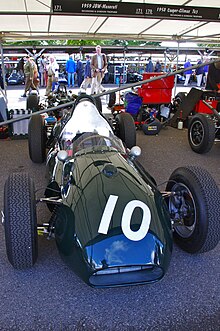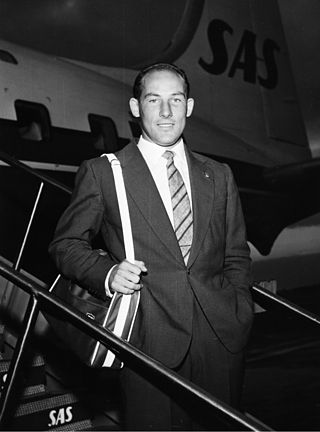
Sir Stirling Craufurd Moss was a British Formula One driver. An inductee into the International Motorsports Hall of Fame, he won 212 of the 529 races he entered across several different motorsports competitions and has been described as "the greatest driver never to win the Formula One World Championship". In a seven-year span between 1955 and 1961 Moss finished in second place four times and in third place three times.
The Surtees Racing Organisation was a race team that spent nine seasons as a constructor in Formula One, Formula 2, and Formula 5000.
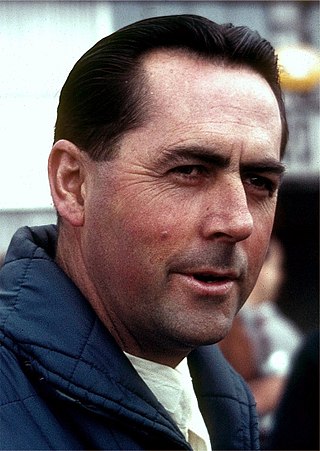
The 1960 Formula One season was the 14th season of the FIA's Formula One motor racing. It featured the 11th FIA World Championship of Drivers, the third International Cup for F1 Manufacturers and numerous non-championship Formula One races. The World Championship commenced on 7 February and ended on 20 November after ten races.

Henry O'Reilly "Harry" Schell was an American Grand Prix motor racing driver. He was the first American driver to start a Formula One Grand Prix.

Masten Gregory was an American racing driver. He raced in Formula One between 1957 and 1965, participating in 43 World Championship races, and numerous non-Championship races. He was also a successful sports car racer, winning the 1965 24 Hours of Le Mans.

Roy Francesco Salvadori was a British racing driver and team manager. He was born in Dovercourt, Essex, to parents of Italian descent. He graduated to Formula One by 1952 and competed regularly until 1962 for a succession of teams including Cooper, Vanwall, BRM, Aston Martin and Connaught. Also a competitor in other formulae, he won the 1959 24 Hours of Le Mans in an Aston Martin with co-driver Carroll Shelby.
Behra-Porsche was a Formula One constructor which entered four World Championship Grands Prix across the 1959 and 1960 seasons. The constructor started - and finished - two races, both in the 1960 season, but scored no championship points in the process.

Joseph Michael Kelly was an Irish racing driver and businessman, who entered into the 1950 and 1951 British Grand Prix.

Reginald Parnell was a racing driver and team manager from Derby, England. He participated in seven Formula One World Championship Grands Prix, achieving one podium, and scoring a total of nine championship points.

Maria Teresa de Filippis was an Italian racing driver, and the first woman to race in Formula One. She participated in five World Championship Grands Prix, debuting on 18 May 1958, but scored no championship points. Though her Formula One racing career was brief, she won races in other series and is remembered as a pioneer in the sport.
Rob Walker Racing Team was a privateer team in Formula One during the 1950s and 1960s. Founded by Johnnie Walker heir Rob Walker (1917–2002) in 1953, the team became F1's most successful privateer in history, being the first and only entrant to win a World Championship Formula One Grand Prix without ever building their own car.
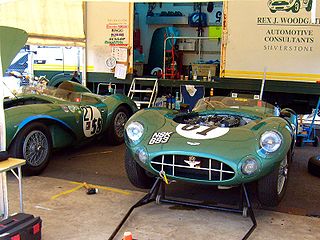
The Aston Martin DBR1 is a sports racing car built by Aston Martin starting in 1956, intended for the World Sportscar Championship as well as non-championship sportscar races at the time. It is most famous as the victor of the 1959 24 Hours of Le Mans, Aston Martin's only outright victory at the endurance classic. It is one of only three cars in the 1950s to win both the World Sports Car Championship and Le Mans 24 Hours in the same year. In addition the six World Sports Car Championship victories was a record for any car in the 1950s and remained a record in the championship until surpassed by the Ferrari 250TR. The three consecutive triumphs in 1959 at the Nürburgring, Le Mans and the Tourist Trophy equalled the record set by the Ferrari 250TR with its three consecutive victories at the start of the 1958 season.

The Maserati 4CL and its derived sister model the Maserati 4CLT are single-seat open-wheel Grand Prix racing cars that were designed and built by Maserati. The 4CL was introduced at the beginning of the 1939 season, as a rival to the Alfa Romeo 158 and various ERA models in the voiturette class of international Grand Prix motor racing. Although racing ceased during World War II, the 4CL was one of the front running models at the resumption of racing in the late 1940s. Experiments with two-stage supercharging and tubular chassis construction eventually led to the introduction of the revised 4CLT model in 1948. The 4CLT was steadily upgraded and updated over the following two years, resulting in the ultimate 4CLT/50 model, introduced for the inaugural year of the Formula One World Championship in 1950. In the immediate post-war period, and the first two years of the Formula One category, the 4CLT was the car of choice for many privateer entrants, leading to numerous examples being involved in most races during this period.
Four-wheel drive (4WD) has only been tried a handful of times in Formula One. In the World Championship era since 1950, only eight such cars are known to have been built.

The Cooper T51 was a Formula One and Formula Two racing car designed by Owen Maddock and built by the Cooper Car Company for the 1959 Formula One season. The T51 earned a significant place in motor racing history when Jack Brabham drove the car to become the first driver to win the World Championship of Drivers with an engine mounted behind them, in 1959. The T51 was raced in several configurations by various entrants until 1963 and in all no less than 38 drivers were entered to drive T51s in Grand Prix races.

Ecurie Bonnier, Ecurie Suisse, Joakim Bonnier Racing Team and Anglo-Suisse Racing Team were names used by Swedish racing driver Joakim Bonnier to enter his own cars in Formula One, Formula Two and sports car racing between 1957 and his death in 1972. Commonly the vehicles were entered for Bonnier himself, but he also provided cars for a number of other drivers during the period.
The 1960 Formula Two season was the last season of 1.5 litre Formula Two racing which was to become Formula One for 1961. Two championships were held over the same five events, the Formula Two Constructors' Championship and the Formula Two Drivers' Championship, in addition to many non-championship Formula Two events. The Constructors' Championship was won in a draw by Cooper-Climax and Porsche, while the Drivers' Championship was won by Jack Brabham.
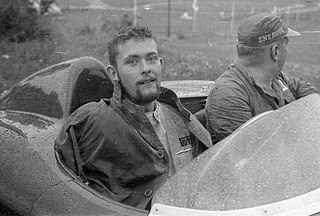
Ulf Norinder was a racing driver from Sweden who competed in multiple classes including non-championship Formula One and the Le Mans 24 hour race in the 1960s and 1970s.

The JBW-Maserati, also known as the JBW Type 1, is a race car, designed, developed, and built by British manufacturer and constructor, JBW, in 1958. It raced in both open-wheel and closed-wheel guises. It competed in both Formula Libre events, as well as 4 Formula One World Championship Grand Prix races, between 1959 and 1961; debuting at the 1959 British Grand Prix, but scored no points over that period of time. It was initially powered by a naturally-aspirated 2.5 L (150 cu in) Maserati 4-cylinder engine four-cylinder engine, which droves the rear wheels through a 5-speed manual transmission. It scored no World Championship points during its time in Formula One racing.
